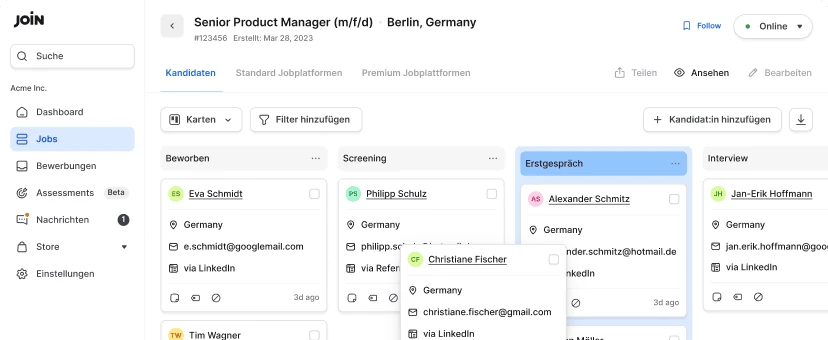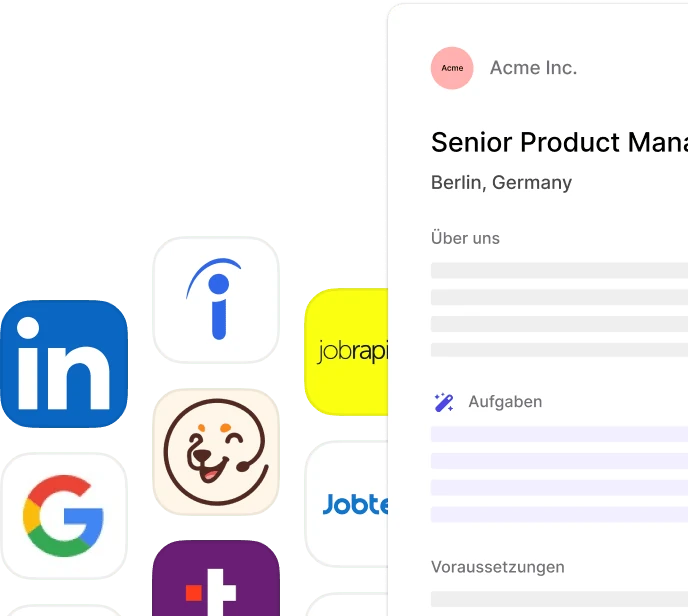Talent acquisition vs recruitment: The difference demystified
In the world of HR, two terms that often get used interchangeably, yet have distinct meanings, are “talent acquisition” and “recruitment”. Knowing the difference will help you decide what’s right for your business.
Table of contents
After all, it’s not just a matter of semantics; talent acquisition and recruiting are not the same. They differ in objectives, scope, and strategies employed. By understanding the nuances between the two, you can optimise your hiring processes to attract the best candidates for your team.
Below, we’ll dive deeper into talent acquisition vs recruitment, show you their respective roles in the hiring process, and help you decide which approach is best for your needs. Here’s all that’s included:
- Talent acquisition vs recruitment
- Determining the right approach for your organisation
- Getting started with recruitment
- Getting started with talent acquisition
- Efficiently grow your business
Talent acquisition vs recruitment
Let’s start by shortly explaining each of the two concepts. After, we’ll compare recruitment and talent acquisition more closely and give you a bunch of information and resources on how to be great at both of them.
What is talent acquisition?
Talent acquisition is a strategic approach to building a strong workforce. It’s a long-term, proactive strategy for attracting top talent and hiring the best candidates.
It not only helps you meet your current hiring needs but also future staffing requirements. It goes beyond the immediate task of filling open positions and focuses on building a talent pipeline and nurturing relationships with potential candidates.
Due to the longer scope and nurturing of potential employees, talent acquisition is particularly important for roles that require specialised skills or leadership capabilities. In other words, the type of roles that tend to take more time to hire someone for.
Also read our talent acquisition glossary
What is recruitment?
Recruitment, on the other hand, is a more reactive process and dynamic approach to hiring. It focuses on filling immediate job vacancies within the organisation.
Recruitment is often used for roles with high turnover rates or positions that require specific skills and qualifications. Unlike talent acquisition, recruitment is more transactional and short-term in nature.
That’s also why the recruitment process has a clearer start and end. Of course, every company’s recruiting process will be slightly different. But the general idea is it starts with you opening a position, and it ends with you filling that position by successfully hiring your new employee.
This is opposed to the acquisition process, which is ongoing and continuous.
The main differences between recruiting and talent acquisition
So, although both are ultimately aimed at finding future employees to strengthen your team, there are several distinct differences.
The main differences between talent acquisition and recruitment can be summarised as follows:
- Approach: Acquisition takes a proactive, long-term approach to acquiring future employees, while recruitment focuses on filling an immediate job opening.
- Strategic vs. transactional: Acquisition is strategic and focuses on building a strong workforce for the future, while recruitment is more transactional and aims to fill specific positions quickly.
- Skills and expertise: Talent acquisition specialists often have a broader skill set and deep understanding of the organisation’s long-term goals, while recruiters excel at processes like sourcing candidates, screening applicants, and ultimately selecting employees for specific roles.
- Planning and flexibility: Acquisition requires careful planning to meet future staffing needs, while recruitment is more flexible and can adapt to immediate hiring demands.

Determining the right approach for your organisation
Deciding whether to prioritise talent acquisition or recruitment depends on various factors, including the organisation’s goals, current staffing needs, the size of your human resources team, and long-term growth plans.
Here are some considerations to help you determine the right approach for your company:
- Assess your hiring needs: Determine whether your business has immediate hiring needs or requires a more long-term strategy. Consider factors such as turnover rates, growth plans, and how easy it is to find good candidates in your industry, niche, and the current workforce climate.
- Evaluate skills and expertise: Assess the skills and expertise of your HR team. If you have HR professionals with a deep understanding of long-term business goals and the ability to develop and execute an effective talent acquisition strategy, then focusing your efforts there might be beneficial. Alternatively, if you have recruiters with strong sourcing and evaluation skills, recruitment may be the more suitable approach.
- Consider the organisation’s culture: Examine your company values and company culture. If investing in employer branding and attracting the most skilled professionals is a priority, acquisition may align better with your needs. However, if filling immediate vacancies quickly is crucial, recruitment may be the more appropriate choice.
- Evaluate cost and time investment: Consider the cost and time investment required for both approaches. A talent strategy may require more resources, planning, and time, while recruitment can deliver more immediate results to fill positions.
Assessing the key differences and taking these considerations into account can help you decide the best approach to boost your organisation’s success.
Of course, your company ideally implements both processes simultaneously. But as this won’t be possible for many (smaller) businesses, you might be forced to pick one of the two. In most cases, focussing on recruitment and the hiring process will be the company’s first choice.
See 2024’s top 5 best recruiting software for small businesses!
So as we dive deeper, let’s start by looking at some of the top steps and strategies to create a rock-solid recruitment process. After, we’ll do the same for talent acquisition.
Getting started with recruitment
Before going into specific strategies to help you recruit great candidates faster and more efficiently, here are the main steps to take to start setting up your process.
Steps to build a recruitment process
The recruitment journey ensures the seamless identification, selection, and integration of top-tier talent into your organisation. An effective recruitment process bridges an organisation’s needs and the pool of potential candidates.
Here’s a quick breakdown to guide you through setting up the process:
- Needs analysis: Begin by understanding the exact requirements and expectations of the role. This involves discussions with department heads, understanding job responsibilities, and determining essential qualifications and skills.
- Job description drafting: Based on your needs analysis, craft a comprehensive job description for the role you’re hiring for. This should outline the role’s primary duties, qualifications needed, potential career progression, and any other important details to attract the right candidates.
- Sourcing strategies: Determine where you’ll find your candidates. This could include posting your job to (free) job sites, university partnerships, recruitment agencies, or networking events.
- Screening process: Develop a system, called a screening process, to filter through applications. This could involve resume reviews (or use a tool that offers resume parsing), phone screenings, or initial assessment tests to gauge the suitability of candidates.
- Interview process: Decide on the number and types of interviews (e.g., behavioural or technical) you’ll conduct. This might include multiple rounds, from HR to department-specific interactions.
- Offer and negotiation: Once a candidate is deemed fit, draft an offer. Be prepared for potential negotiations regarding salary, benefits, or role specifics.
- Onboarding procedure: Ensure a smooth transition for the new hire. This involves orientation programs, training sessions, and integrating the new member into the company culture.
Regularly revisiting and refining this process is crucial to continually attracting and retaining the best talent, thereby driving organisational success.
Further recruitment tips
Once you set up your process, you can start exploring different tactics to further improve your ongoing strategy.
You can cCheck out our dedicated article for the top 11 recruitment strategies! Alternatively, here are a few more tips to help you recruit talent more effectively:
- Implement employee referral programs: Engage your existing staff to hire prospective candidates. By offering employee referral incentives for successful hires, you can leverage the networks of your current employees to find suitable candidates.
- Improve your digital presence: Optimise your company’s website and online platforms to appeal to potential hires. This includes creating a great career page, coupled with testimonials and insights into the company culture.
- Start diversity and inclusion initiatives: Embrace policies that welcome candidates from various backgrounds. This not only broadens your talent pool but also promotes a more inclusive and holistic work environment. For more information, check out our dedicated article on the best diversity recruitment strategies.
- Try social media recruitment: Use platforms like LinkedIn, Twitter, and Instagram to share and promote job openings and engage with potential candidates. For information, check out social recruiting.
- Implement skills assessment tests: Use online assessment tools and platforms (or pick a (free) recruitment software with this feature) to evaluate the skills and aptitude of prospective candidates, ensuring they align with the role’s requirements.

Getting started with talent acquisition
As mentioned, most companies (especially small-to-medium businesses) start with recruitment. But to effectively and continuously attract the most suitable candidates that can help you bridge a skills gap and fill vacancies, you’ll need a talent acquisition strategy as well.
Whereas a large part of recruitment is effectively owned by hiring managers, the acquisition process is generally owned by dedicated acquisition specialists.
Steps to build a talent acquisition process
Here are a few steps HR professionals can follow to start optimising their talent acquisition efforts:
- Evaluate the organisation: Consult with management and business leaders to understand the organisation’s objectives and long-term talent requirements. Gain insights into the needs of each department and identify any upcoming changes or challenges that may impact staffing needs.
- Perform a talent gap analysis: Review the skills and competencies of current employees to identify any gaps or areas of improvement. Analyse performance evaluations and exit interview data to determine the skills needed to achieve business objectives.
- Build a talent acquisition strategy: Based on the skills requirements and ideal candidate profiles, develop a comprehensive strategy for attracting and recruiting the right talent. We’ll highlight some of the top tactics below.
- Implement talent management initiatives: Once candidates are hired, HR professionals should implement talent management programs to help employees develop the skills and competencies needed to succeed. This can include training, mentoring, coaching, and other forms of learning and development.
- Monitor and evaluate: Continuously monitor and evaluate the effectiveness of talent acquisition and management strategies. Track talent acquisition metrics and KPIs and make adjustments as necessary to optimise outcomes.
Further talent acquisition tips
To implement a successful talent acquisition strategy, organisations can employ various tactics, including:
- Employer branding: Building a positive employer brand that showcases the organisation as an ideal workplace for top talent. This involves highlighting the company’s values, culture, and opportunities for growth and development.
- Recruitment marketing: Promoting job opportunities to potential candidates through various channels, such as social media, job boards, and targeted advertising. Effective recruitment marketing strategies focus on engaging candidates and creating a positive candidate experience.
- Talent sourcing: Proactively searching for and engaging with passive candidates who may be a good fit for future roles. This can involve leveraging social media, professional networks, and industry events to identify and connect with potential candidates.
- Employee referrals: Encouraging current employees to refer qualified candidates from their personal and professional networks. Employee referral programs can be highly effective in attracting candidates who are a good cultural fit for the organisation.
- Talent pooling: Building a talent pool or pipeline involves identifying, nurturing, and recruiting potential candidates to create a pool of qualified individuals who can fill roles as needed. This approach ensures a continuous talent supply and reduces the time and effort required to fill vacancies.
- Succession planning: Prioritising internal promotions and career development to fill key organisational roles. Succession planning helps organisations retain top talent and reduce recruitment costs while providing growth opportunities for existing employees.
For more inspiration, check out our article on effective talent acquisition strategies to attract great talent!
Efficiently grow your business
Recruitment and talent acquisition are two distinct approaches to finding and hiring top talent. Whereas the first focuses on filling an existing vacancy and your company’s immediate needs, the latter is all about long term strategic aims.
That said, each is a critical component in getting qualified candidates and growing your company. Which is why any forward thinking company should try to include both in their set of business strategies. Check out more resources to help you excel at both:
Frans Lelivelt
Frans is JOIN's multilingual Senior Content Manager. His main topic of interest in the recruitment space is DEI and how companies can reduce their (unconscious) biases to make the world of work a fairer, kinder place for everyone. Outside of work, he tries to do the same for animals, spending much of his spare time in the kitchen preparing plant-based feasts.


